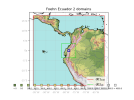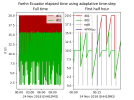Dear all,
This is my first time that I use adaptive time-step in WRF.
I am trying to run over Ecuador (South America) down to 2 km. See domain below:

I am forcing with ERA5. I have insane CFL problems to start the simulation so, I recall about adaptive time-step. So I thought to perform 1 simulation day with a lot of dynamical restrictions to get a first restart and then start a proper simulation from there. So in my namelist (I attached the full version) I have:
So far I managed to simulate, but then I realize that in the
I realized that the time step fluctuates. Curious about that (I would thought that as times goes by it will become somewhat stable) I got the values for the first12 hours of simulation and I plot them as you can see below:

Fig2. Left panel time-step used to integrate each domain (d01: red, d02: green) during the first 12 hours. Right panel, zoom of the first half hour. Gray lines indicate calls to the radiative scheme (
I checked
Just to understand the behavior of the model, does anyone have any explanation for this?
Many thanks in advance,
Lluís
This is my first time that I use adaptive time-step in WRF.
I am trying to run over Ecuador (South America) down to 2 km. See domain below:

I am forcing with ERA5. I have insane CFL problems to start the simulation so, I recall about adaptive time-step. So I thought to perform 1 simulation day with a lot of dynamical restrictions to get a first restart and then start a proper simulation from there. So in my namelist (I attached the full version) I have:
Code:
&domains
smooth_option = 1,
use_adaptive_time_step = .true.,
step_to_output_time = .true.
target_cfl = 1.0, 1.0, 1.0,
max_step_increase_pct = 5, 51, 51,
max_time_step = 20,
min_time_step = 1,
smooth_cg_topo = .false.
/
&dynamics
hybrid_opt = 2,
w_damping = 1,
diff_opt = 2, 2, 2,
km_opt = 4, 4, 4,
diff_6th_opt = 0, 1, 0,
diff_6th_factor = 0.12, 0.12, 0.12,
diff_6th_slopeopt = 1,
diff_6th_thresh = 0.1, 0.1, 0.1,
base_temp = 290.,
damp_opt = 3,
zdamp = 4000., 4000., 4000.,
dampcoef = 0.2, 0.2, 0.2,
khdif = 0, 0, 0,
kvdif = 0, 0, 0,
epssm = 0.9, 0.9,
non_hydrostatic = .true., .true., .true.,
moist_adv_opt = 1, 1, 1,
scalar_adv_opt = 1, 1, 1,
gwd_opt = 1, 0, 0,
/So far I managed to simulate, but then I realize that in the
rsl.error.0000 appears de actual time step being used during the simulation as for example:
Code:
(...)
Timing for main (dt= 15.53): time 2018-11-24_01:37:53 on domain 1: 13.43241 elapsed seconds
Timing for main (dt= 8.15): time 2018-11-24_01:38:01 on domain 2: 3.40214 elapsed seconds
Timing for main (dt= 8.15): time 2018-11-24_01:38:09 on domain 2: 2.84357 elapsed seconds
Timing for main (dt= 16.31): time 2018-11-24_01:38:09 on domain 1: 16.08749 elapsed seconds
Timing for main (dt= 8.56): time 2018-11-24_01:38:17 on domain 2: 3.40707 elapsed seconds
Timing for main (dt= 8.56): time 2018-11-24_01:38:26 on domain 2: 3.69092 elapsed seconds
Timing for main (dt= 17.13): time 2018-11-24_01:38:26 on domain 1: 16.56759 elapsed seconds
Timing for main (dt= 8.99): time 2018-11-24_01:38:35 on domain 2: 3.73254 elapsed secondsI realized that the time step fluctuates. Curious about that (I would thought that as times goes by it will become somewhat stable) I got the values for the first12 hours of simulation and I plot them as you can see below:

Fig2. Left panel time-step used to integrate each domain (d01: red, d02: green) during the first 12 hours. Right panel, zoom of the first half hour. Gray lines indicate calls to the radiative scheme (
radt = 3,3),whereas blue lines indicate output written in file (history_interval = 180, 15,)I checked
namelist.output and does not seem to be any other parameter in the namelist that could explain this cyclic behavior of around 5 minutes.Just to understand the behavior of the model, does anyone have any explanation for this?
Many thanks in advance,
Lluís
